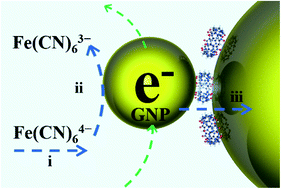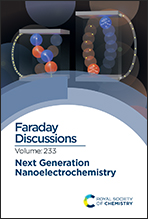Nanocollision mediated electrochemical sensing of host–guest chemistry at a nanoelectrode surface†
Abstract
Electrochemical (EC) measurements of dynamic nanoparticle collisions on a support electrode provide a powerful approach to study the electrical properties of interfacial molecules self-assembled on the electrode surface. By introducing a special cage-shaped macrocyclic molecule, cucurbit[7]uril (CB7), onto a gold nanoelectrode surface, we show that the dynamic interactions between CB7 and the colliding nanoparticles can be real-time monitored via the appearance of distinct EC current switching signals. When a guest molecule is included in the CB7 cavity, the changed host–guest chemistry can be probed via the amplitude change of the EC current signals. In addition, different guest molecules can be recognized by CB7 on the nanoelectrode surface, giving rise to distinguishable current jump signals for different host–guest systems. Remarkably, two well-defined current states are observed in the EC measurements of the CB7–ferrocene complex, indicating two orientation geometries of ferrocene inside the CB7 cavity can be resolved in this EC sensing platform. This work demonstrates an effective approach for studying the dynamics of host–guest chemistry at the liquid–solid interface and sheds light on a convenient EC sensor for the recognition of target molecules with the aid of CB7.

- This article is part of the themed collection: Next Generation Nanoelectrochemistry


 Please wait while we load your content...
Please wait while we load your content...